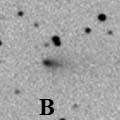
|
It reached to 5 mag at best in early May at the remarkable approach to the earth, when it became double naked eye comets with the component C around the zenith. Now it is going away from the earth and fading. It has already faded down to 7.6 mag (May 31, Willian Souza). But the apparent distance between the two components is reduced and two bright comets become to be in the same field. It still locates high in the Southern Hemisphere. But in the Northern Hemisphere, it locates extremely low in the morning in June. It will be getting higher gradually after July, however, it will be fading rapidly. Now it is a bit fainter than the component C. But it is still close to the sun. So another another outburst may occur due to the nuclear split.
Date(TT) R.A. (2000) Decl. Delta r Elong. m1 Best Time(A, h)
June 3 1 1.75 -6 49.1 0.179 0.942 61 7.3 5:30 (243, 42)
June 10 1 23.26 -9 43.1 0.234 0.940 64 7.9 5:33 (244, 46)
|
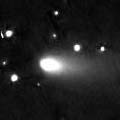
|
It reached to 6 mag at best in early May at the remarkable approach to the earth, when it became double naked eye comets with the component B around the zenith. Now it is going away from the earth and fading. It has already faded down to 7.3 mag (May 31, Willian Souza). But the apparent distance between the two components is reduced and two bright comets become to be in the same field. It still locates high in the Southern Hemisphere. But in the Northern Hemisphere, it locates extremely low in the morning in June. It will be getting higher gradually after July, however, it will be fading rapidly.
Date(TT) R.A. (2000) Decl. Delta r Elong. m1 Best Time(A, h)
June 3 0 55.01 -7 25.0 0.201 0.941 63 7.5 5:30 (242, 44)
June 10 1 17.85 -9 42.4 0.255 0.940 65 8.1 5:33 (243, 47)
|

|
It brightened much more rapidly than expected after late April. Now it reaches to 9.8 mag (May 30, Juan Jose Gonzalez). It becomes brightest in June and will start fading after July. But it keeps observable in the evening until autumn when it becomes too faint to see. It keeps locating around 30 degree high. Great outburst over 6 mag has occured always in recent appearances in 1995 and 2001. So it may brighten much more after this.
Date(TT) R.A. (2000) Decl. Delta r Elong. m1 Best Time(A, h)
June 3 9 14.83 23 42.4 1.034 1.055 61 9.8 18:25 (151, 25)
June 10 9 45.02 22 21.0 1.008 1.048 62 9.6 18:25 (151, 27)
|

|
The condition is worst in this time, not visible in the Northern Hemisphere at all. Now it is observable only in the Southern Hemisphere in the morning low sky. It was observed on May 24 by Michael Jager and Gerald Rhemann. The comet looks bright in their photo. It is brightening very rapidly after this, however, it is also getting lower very rapidly. In mid June, it will be 10 mag but will be too low to observe.
Date(TT) R.A. (2000) Decl. Delta r Elong. m1 Best Time(A, h)
June 3 2 18.13 11 14.1 1.290 0.763 36 13.0 5:30 (243, 16)
June 10 3 5.38 15 7.6 1.298 0.672 30 11.4 5:33 (243, 11)
|

|
It had been observed at 10 mag in the evening sky from winter to spring. But now it is not observable. It will appear in the morning sky again in late August at 13.5 mag. It will come to locate high in October, then it will be visible visually again at 14 mag.
Date(TT) R.A. (2000) Decl. Delta r Elong. m1 Best Time(A, h)
June 3 5 26.57 34 30.0 2.991 2.032 15 11.9 18:25 (121,-16)
June 10 5 47.08 34 37.1 3.064 2.093 13 12.0 18:25 (120,-17)
|
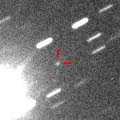
|
It was 11.7 mag on May 26 (Juan Jose Gonzalez). It keeps 12 mag until July. The condition is best beucase it is almost at opposition at the perihelion passage. However, it keeps very low, only 13-20 deg high until September in the Northern Hemisphere. When it gets higher again, it will be fainter than 14 mag, too faint to see visually.
Date(TT) R.A. (2000) Decl. Delta r Elong. m1 Best Time(A, h)
June 3 19 25.83 -32 33.8 0.630 1.563 142 12.0 2:41 (180, 87)
June 10 19 32.08 -34 24.2 0.608 1.562 147 11.9 2:20 (180, 89)
|

|
Now it is 12.8 mag (May 25, Juan Jose Gonzalez). Diffuse visually. It had been originally expected to reach to 9 mag at best. However, the brightness evolution had been very slow, and actually it is much fainter than originally expected. But with a large telescope, it is still bright and enjoyable. It will be observable in good condition after this until autumn. It will be visible bright as 12 mag for a while.
Date(TT) R.A. (2000) Decl. Delta r Elong. m1 Best Time(A, h)
June 3 17 49.17 24 8.6 1.404 2.206 130 12.4 1:06 (180, 31)
June 10 17 21.17 27 23.5 1.480 2.266 129 12.6 0:11 (180, 28)
|

|
The components G, R, and other several fragments became bright up to 12-14 mag and visible visually from April to early May. However, all fragments were reported so faint after mid May. They still locate high in the Southern Hemisphere. But in the Northern Hemisphere, they are already extremely low in the morning. However, it is rather close to the earth still now, so some fragments may brighten up to 13-14 mag again after this.
Date(TT) R.A. (2000) Decl. Delta r Elong. m1 Best Time(A, h)
June 3 1 3.49 -6 36.1 0.173 0.943 60 12.7 5:30 (244, 42)
June 10 1 24.63 -9 43.4 0.227 0.940 64 13.3 5:33 (245, 46)
|
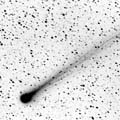
|
It reached to 5.2 mag at best in late February and early March. It is fading rapidly, however, it is still bright as 12.2 mag (May 25, Juan Jose Gonzalez), brighter than this ephemeris. But now it is very diffuse. In the Northern Hemisphere, it keeps observable in good condition until it becomes too faint to see.
Date(TT) R.A. (2000) Decl. Delta r Elong. m1 Best Time(A, h)
June 3 2 10.06 68 17.2 2.438 1.975 51 13.8 5:30 (200,-22)
June 10 2 24.80 69 18.4 2.532 2.077 52 14.2 5:33 (198,-22)
|

|
It did not brighten so frequently in 2005. But it was often bright as 12-13 mag in early 2006. Now it is not observable. It will appear again at dawn in July. Then it will be observable in good condition in autumn and winter.
Date(TT) R.A. (2000) Decl. Delta r Elong. m1 Best Time(A, h)
June 3 3 22.64 26 45.5 6.764 5.813 18 13.9 5:30 (241, -5)
June 10 3 28.59 27 8.0 6.730 5.814 23 13.9 5:33 (237, -1)
|

|
It has been visible at 13.5 mag since last October. Small and strongly condensed. It kept observable in good condition for a long time, but it will be getting lower in the evening, and will be too low to observe in July. However, it will be observable in good condition again at 14.5 mag in next winter.
Date(TT) R.A. (2000) Decl. Delta r Elong. m1 Best Time(A, h)
June 3 10 3.56 43 14.4 5.501 5.207 67 13.9 18:25 (167, 10)
June 10 10 9.08 42 13.7 5.585 5.211 63 14.0 18:25 (163, 10)
|

|
It was 15.5 mag on May 30 (Ernesto Guido and Giovanni Sostero), brightening as expected. Although it is still low in the morning sky, it will be getting higher and brightening rapidly after this. It will be 14 mag and visible visually in June. It will reach to 8.5 mag from autumn to winter, and observable in its best condition. It keeps 14 mag still in 2007 April, so it keeps visible visually for a long time.
Date(TT) R.A. (2000) Decl. Delta r Elong. m1 Best Time(A, h)
June 3 23 30.83 4 25.3 2.285 2.287 77 14.6 5:30 (208, 47)
June 10 23 41.96 5 37.9 2.171 2.246 80 14.3 5:33 (201, 47)
|

|
Although it was not observed in its last return in 1999, it will be observable in good condition after the periheliion passage in this return. It will reach to 14.5 mag from June to August. Now it is appearing at dawn.
Date(TT) R.A. (2000) Decl. Delta r Elong. m1 Best Time(A, h)
June 3 1 2.25 13 6.2 2.409 1.974 53 14.7 5:30 (227, 28)
June 10 1 14.85 15 40.8 2.353 1.974 56 14.7 5:33 (221, 28)
|

|
In 2005 spring, it reached to 14 mag and became visible visually as 13.8 mag (July 8, Reinder J. Bouma). In 2006, it will be the same condition and brightness in summer again. Somewhat low in the south. But it will reach to 14 mag.
Date(TT) R.A. (2000) Decl. Delta r Elong. m1 Best Time(A, h)
June 3 22 37.67 -18 47.4 2.836 3.144 98 15.2 5:30 (199, 73)
June 10 22 41.94 -18 46.3 2.753 3.153 103 15.2 5:29 (180, 74)
|

|
It is outside of Jupiter's orbit, so it keeps observable for a long time. In 2006, it is still faint and locating somewhat low. But in 2007 and 2008, it is expected to be bright as 14.5-15 mag. It will locate high at that time, so it may be visible visually.
Date(TT) R.A. (2000) Decl. Delta r Elong. m1 Best Time(A, h)
June 3 20 11.29 -24 38.6 6.279 7.004 132 16.0 3:27 (180, 80)
June 10 20 6.02 -24 36.9 6.164 6.975 140 16.0 2:54 (180, 80)
|

|
It is unexpectedly bright as 15.5 mag on Apr. 2 (Ken-ichi Kadota). But it keeps very low until June. It will be getting higher after it starts fading. However, it has ever become a naked eye object in outburst, so observations are encouraged.
Date(TT) R.A. (2000) Decl. Delta r Elong. m1 Best Time(A, h)
June 3 23 36.06 -7 43.0 1.748 1.876 80 16.2 5:30 (219, 57)
June 10 23 47.76 -7 16.7 1.712 1.907 84 16.3 5:33 (211, 59)
|

|
It was fantastic, so bright as 3.5 mag, so large as 30 arcmin, locating high overhead at its best time in early 2004 January. Then it has been getting fainter gradually, and become already too faint to see visually. However, it is still bright as 15.8 mag by CCD observations (Mar. 30, Katsumi Yoshimoto). It keeps observable until October when it becomes fainter than 18 mag.
Date(TT) R.A. (2000) Decl. Delta r Elong. m1 Best Time(A, h)
June 3 16 26.56 3 12.6 4.973 5.903 154 16.2 23:38 (180, 52)
June 10 16 22.37 3 2.3 5.055 5.966 151 16.3 23:07 (180, 52)
|

|
It was 15.8 mag on Feb. 9 (Ken-ichi Kadota). It will be observable in good condition as 16 mag for a long time until next spring. It was too faint to see visually, fainter than 13.9 mag (Mar. 31, Seiichi Yoshida).
Date(TT) R.A. (2000) Decl. Delta r Elong. m1 Best Time(A, h)
June 3 10 41.43 55 43.4 5.277 5.049 71 16.5 18:25 (176, -1)
June 10 10 47.57 54 28.4 5.350 5.059 68 16.5 18:25 (173, 0)
|
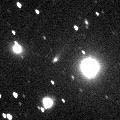
|
In 2005, it had been observed at 16 mag by CCD, or 14 mag visually, in spring and summer. It will be observable again at 16.5 mag in spring and summer in 2006. But the altitude will be somewhat lower than in 2005.
Date(TT) R.A. (2000) Decl. Delta r Elong. m1 Best Time(A, h)
June 3 19 35.30 -9 59.1 3.274 4.075 136 16.6 2:51 (180, 65)
June 10 19 30.24 -11 21.7 3.227 4.101 145 16.6 2:19 (180, 66)
|

|
It has been lost since its discovery in 1986. The condition is good in this return. In calculation, it will be 14 mag from autumn to winter. However, it was probably in outburst and brightened unexpectedly at the discovery. So it can be much fainer than this ephemeris actually. In the Northern Hemisphere, it keeps observable until it fades out in next spring.
Date(TT) R.A. (2000) Decl. Delta r Elong. m1 Best Time(A, h)
June 3 18 18.61 -24 3.5 1.296 2.268 157 16.9 1:35 (180, 79)
June 10 18 13.41 -24 1.2 1.221 2.219 165 16.6 1:02 (180, 79)
|
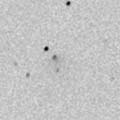
|
It is outside of Jupiter's orbit. So it keeps 16.5-17 mag for a long time. Because it moves in the northern sky, it keeps locating high and observable in good condition until 2006 summer.
Date(TT) R.A. (2000) Decl. Delta r Elong. m1 Best Time(A, h)
June 3 13 26.57 64 18.7 6.843 6.838 85 16.8 20:39 (180, -9)
June 10 13 22.36 63 6.1 6.894 6.844 82 16.8 20:07 (180, -8)
|

|
It was 16.0 mag on Mar. 13 (Ken-ichi Kadota). It kept 16-16.5 mag for about one year from early 2005. It had been locating somewhat low for a while, but it will be higher after this. It keeps 17 mag until autumn when the condition becomes good.
Date(TT) R.A. (2000) Decl. Delta r Elong. m1 Best Time(A, h)
June 3 0 42.92 54 9.6 3.826 3.343 54 16.8 5:30 (201, -5)
June 10 0 49.93 54 15.6 3.801 3.363 57 16.8 5:33 (198, -3)
|
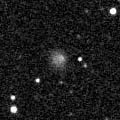
|
It had been an extremely faint Centaur asteroid until 2004, fainter than 21 mag. However, it brightened up to 17.5 mag on 2005 Dec. 30, and a coma was observed, then it was revealed to be a comet. It brightened furthermore, 14.8 mag on Jan. 7 (Ken-ichi Kadota). It was also visible visually at 14.4 mag (Jan. 8, Seiichi Yoshida). It still keeps bright as 15.7 mag on Apr. 16 (Mitsunori Tsumura). Now the condensation of the outburst looks separatedly from the nucleus. Because it is a temporary brightening in outburst, it will return to be so faint as 21 mag in the near future. It will pass the perihelion in 2015. The heliocentric distance reduces down to 5.9 A.U., but it will be 17 mag at best. However, another outburst may happen again in the future.
Date(TT) R.A. (2000) Decl. Delta r Elong. m1 Best Time(A, h)
June 3 12 57.79 -4 3.7 12.221 12.796 122 16.9 20:10 (180, 59)
June 10 12 57.22 -4 0.6 12.309 12.783 115 17.1 19:42 (180, 59)
|

|
Peculiar asteroid moving along a comet-like orbit. It will reach to 14 mag in next January. It keeps observable in good condition after this while getting brighter rapidly. It may turn to be a comet after this.
Date(TT) R.A. (2000) Decl. Delta r Elong. m1 Best Time(A, h)
June 3 22 38.84 -1 9.7 2.700 2.907 91 17.4 5:30 (191, 56)
June 10 22 42.79 0 19.0 2.541 2.842 96 17.2 5:30 (180, 55)
|

|
It was observed at 17 mag in 2005 summer. It will reach to 17 mag again in 2006 summer.
Date(TT) R.A. (2000) Decl. Delta r Elong. m1 Best Time(A, h)
June 3 22 42.56 -8 32.6 3.011 3.233 93 17.5 5:30 (195, 63)
June 10 22 46.80 -8 20.2 2.923 3.240 98 17.4 5:33 (181, 63)
|
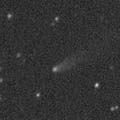
|
Although it was faint as 18 mag at the discovery in 2004 November, then it brightened very rapidly until early 2005, and reached to 16.0 mag on May 7 (Ken-ichi Kadota). After it appeared in the morning sky again, it continued brightening furthermore, and reached to 14.7 mag on Nov. 22 (Ken-ichi Kadota). It was also visible visually as 14.4 mag (Mar. 29, Maciej Reszelski). However, it already faded down to 16.6 mag by CCD observations (Apr. 20, Mitsunori Tsumura). In the Northern Hemisphere, it keeps observable in good condition until summer when it becomes too faint.
Date(TT) R.A. (2000) Decl. Delta r Elong. m1 Best Time(A, h)
June 3 13 16.56 10 21.3 2.513 3.143 119 17.6 20:29 (180, 45)
June 10 13 16.65 9 16.7 2.622 3.175 114 17.8 20:02 (180, 46)
|
|
![]()
 C/2005 E2 ( McNaught )
C/2005 E2 ( McNaught ) 71P/Clark
71P/Clark C/2004 B1 ( LINEAR )
C/2004 B1 ( LINEAR ) 73P/Schwassmann-Wachmann 3 (fainter fragments)
73P/Schwassmann-Wachmann 3 (fainter fragments) C/2006 A1 ( Pojmanski )
C/2006 A1 ( Pojmanski ) 29P/Schwassmann-Wachmann 1
29P/Schwassmann-Wachmann 1 C/2003 WT42 ( LINEAR )
C/2003 WT42 ( LINEAR ) 4P/Faye
4P/Faye 102P/Shoemaker 1
102P/Shoemaker 1 117P/Helin-Roman-Alu 1
117P/Helin-Roman-Alu 1 C/2005 L3 ( McNaught )
C/2005 L3 ( McNaught ) 98P/Takamizawa
98P/Takamizawa C/2004 Q2 ( Machholz )
C/2004 Q2 ( Machholz ) C/2004 D1 ( NEAT )
C/2004 D1 ( NEAT ) C/2005 K1 ( Skiff )
C/2005 K1 ( Skiff ) D/1986 W1 ( Lovas 2 )
D/1986 W1 ( Lovas 2 ) C/2002 VQ94 ( LINEAR )
C/2002 VQ94 ( LINEAR ) C/2005 B1 ( Christensen )
C/2005 B1 ( Christensen ) 174P/(60558) 2000 EC98 ( Echeclus )
174P/(60558) 2000 EC98 ( Echeclus ) 2006 HR30
2006 HR30 P/2005 L1 ( McNaught )
P/2005 L1 ( McNaught ) P/2004 VR8 ( LONEOS )
P/2004 VR8 ( LONEOS )![]()
















